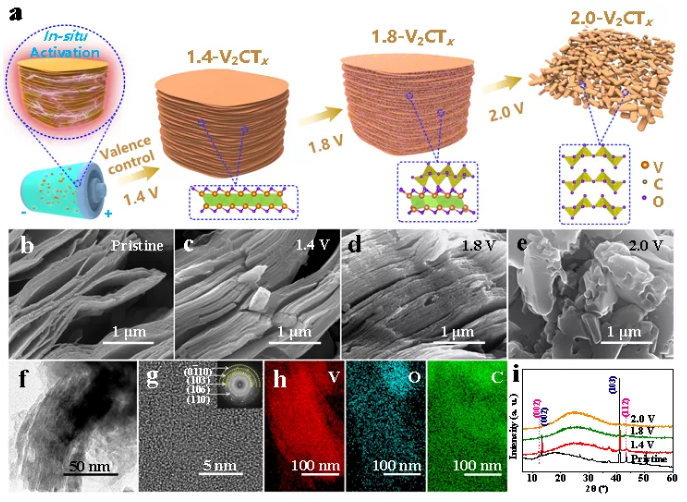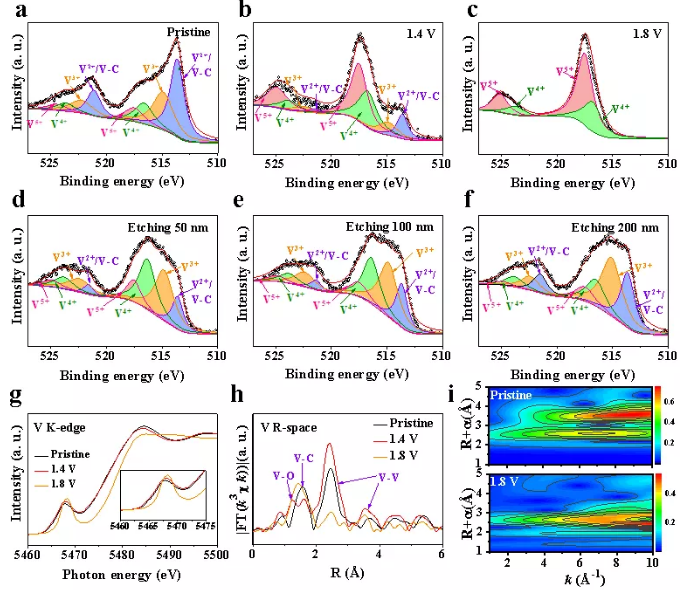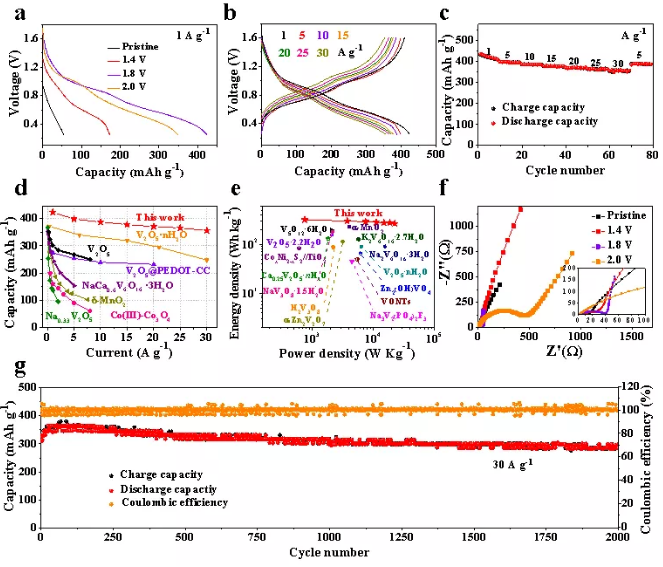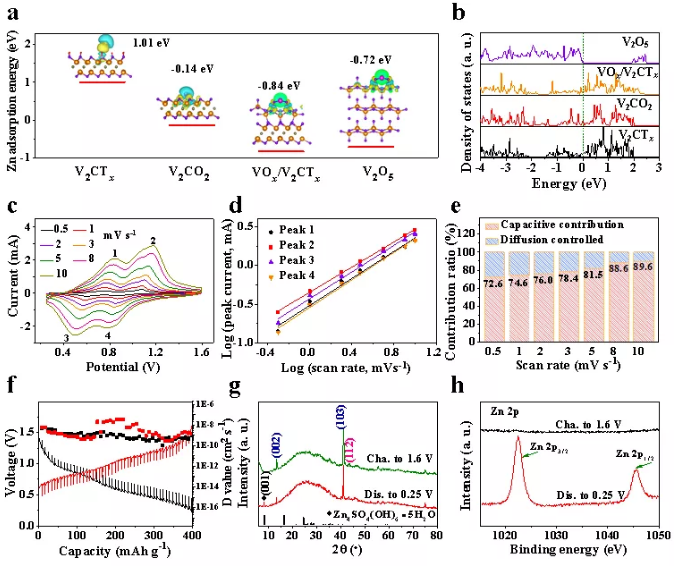
【Research Background】
Aqueous zinc-ion batteries use neutral/weakly acidic zinc ion-containing aqueous solutions as electrolytes. They have the advantages of high ion conductivity, low cost, environmental protection and safety, and excellent performance. They are considered to be the next-generation secondary battery technology that is expected to replace lithium-ion batteries. , Has attracted widespread attention in recent years. Vanadium-based cathode materials can theoretically provide high discharge capacity by virtue of the multiple variable valence states of vanadium. It is an ideal choice for the development of high specific energy zinc ion batteries and large-scale commercial use. However, such materials generally have problems such as low electronic/ionic conductivity and vanadium dissolution, resulting in battery rate and cycle performance far below expectations. Therefore, how to realize a zinc ion battery with high specific energy, high rate and high stability based on vanadium-based cathode materials is still a scientific problem to be solved.
【Job Introduction】
Recently, Dr. Huang Yang and Dr. Zhang Wang of Shenzhen University and Professor Shulei of the University of Wollongong in Australia used an in-situ electrochemical charging and activation method to regulate the oxidation reaction of the V2CTx MXene/electrolyte interface, maintaining the conductive structure of the VCV inside the V2CTx On this basis, the outer vanadium atom valence state is rapidly increased to achieve high specific energy and high rate zinc ion storage performance; and the structural and chemical bonding changes of V2CTx during the charge and discharge process are systematically studied, and the vanadium atom valence state and zinc are discussed. Interrelationship of ion storage performance. Related work results were published on Advanced Functional Materials with the title In-situ electrochemically activated surface vanadium valence in V2C MXene to achieve high capacity and superior rate performance for Zn-ion batteries . Dr. Liu Ying from Shenzhen University was the first author of the paper.
【Content Expression】
The emergence of V2C MXene with ultra-high electrical conductivity and rich surface chemistry provides a huge opportunity for the construction of high-performance zinc-ion batteries. The accordion-like V2CTx, which is stacked by a large number of V-C-V atoms, has a large number of ordered nanochannels, which can effectively promote charge transfer, and can be used as a multi-branch parallel circuit to provide high power output. Although the surface of two-dimensional V2CTx can provide sufficient reactive sites for the intercalation/extraction of zinc ions, V2CTx usually only provides unreasonably low discharge capacity. Therefore, there are few reports of using V2CTx as a high-performance anode for ZIBs. We believe that the main reason for the low discharge capacity of V2CTx is that its V atoms (+2 and +3) have low chemical valences, which cannot participate in multi-electron redox reactions through high- and low-valence conversions during charge and discharge. Considering that vanadium has multiple valence states, theoretically, the zinc ion storage capacity of V2CTx can be improved by increasing the valence state of vanadium atoms. More importantly, if the conductive two-dimensional structure of V2CTx can be retained, the electronic/ionic conductivity of vanadium-based materials can be significantly improved, and a high-capacity, high-rate zinc-ion battery based on V2CTx cathode can be obtained.
V2CTx is a typical member of the MXene family. When exposed to water or air, it will gradually oxidize, causing the valence of the outermost vanadium atom to change. This motivates us to release the potential of V2CTx to store zinc ions by adjusting the valence state of vanadium on its surface in situ. As shown in Figure 1, first, an accordion-shaped V2CTx is prepared by selectively etching the aluminum atoms of the V2AlC precursor. V2CTx powder is mixed with carbon nanotubes (CNTs), and a flexible electrode with a three-dimensional interpenetrating structure is formed through a vacuum filtration method. Then, in order to induce the oxidation of the vanadium atoms in the outermost layer of V2CTx, during the first charging process, the V2CTx electrode is charged under a stable voltage window higher than water (1.4 V, 1.8 V and 2.0 V). By precisely controlling the activation voltage and time, we can generate a high-valence nano-VOx in situ on the two-dimensional sheet of V2CTx, while preserving its internal ordered nano-channels, that is, the V-C-V multilayer structure.

Figure 1. The morphology and structure evolution of V2CTx electrodes under different activation voltages. (a) Schematic diagram of electrochemical regulation of the valence of V2CTx. (b-e) SEM images of original V2CTx, 1.4-V2CTx, 1.8-V2CTx, 2.0-V2CTx. (f) TEM image, (g) HRTEM image, inset is the FFT image corresponding to 1.8-V2CTx. (h) EDX spectrum of 1.8-V2CTx. (i) XRD patterns of original V2CTx, 1.4-V2CTx, 1.8-V2CTx, 2.0-V2CTx.
As shown in Figure 2, in the original V2CTx, the peak intensities of V-C /V2+ and V3+ are higher, indicating that low-priced vanadium is dominant, which is consistent with previous reports. With the increase of the charging voltage, the V-C/V2+ and V3+ peaks of the V2CTx electrode gradually disappeared after activation, while the V4+ and V5+ peak intensity increased significantly. These high-valent vanadium species are derived from the VOx generated by surface oxidation during the charge activation process. The deep-etched XPS pattern further proves that the inner V-C-V structure is still preserved after activation. The EXANES spectrum shows that the energy of the absorption edge increases after charging activation, indicating that the oxidation state of vanadium increases, which is consistent with the above XPS results. In addition, the study found that the absorption edge energy of 1.8-V2CTx is higher than that of 1.4-V2CTx, which is close to VO2 and V2O5, indicating that the V atom oxidation state of 1.8-V2CTx is higher.

Figure 2. The chemical state and electronic structure of the V2CTx electrode under different activation voltages. (a-c) XPS spectra of original V2CTx, 1.4-V2CTx and 1.8-V2CTx of vanadium. (d-f) XPS spectra of 1.8-V2CTx at different etching depths. (G-h) k-edge extended X-ray absorption near-edge structure (XANES) spectra and Fourier transform V k-edge EXAFS spectra of original V2CTx, 1.4-V2CTx and 1.8-V2CTx. (i) Wavelet transform (WT) maps of the original V2CTx and 1.8-V2CTx.
Figure 3a shows that without initial charge activation, the original V2CTx capacity is relatively low, only 55 mAh g-1. Interestingly, after the initial charge of 1.4 V, the discharge capacity of V2CTx was immediately improved to 172.7 mAh g-1. Further increasing the charging voltage can significantly increase the discharge capacity of V2CTx. For example, the discharge capacity of 1.8-V2CTx is 423.5 mAh g-1; due to its high V content, the capacity is much better than 1.4-V2CTx. However, the discharge capacity of 2.0-V2CTx dropped to 348.7 mAh g-1. This apparent capacity decay is due to the collapse of the V-C-V two-dimensional multilayer structure in 2.0-V2CTx, which severely reduces the electrochemical reaction sites, and at the same time hinders the transport of electrons and ions during charge and discharge. It is worth noting that the discharge capacity of 1.8-V2CTx is almost unaffected under high current density. This excellent rate performance is far superior to many ZIBs that have been reported.

Figure 3. Electrochemical performance of the V2CTx electrode storing zinc ions under different activation voltages. (a) The discharge curve of original V2CTx, 1.4-V2CTx, 1.8-V2CTx, 2.0-V2CTx at 1 A g-1. (b) Charge and discharge curves of 1.8-V2CTx at different current densities. (c) 1.8-V2CTx rate performance. (d) Comparison chart of rate performance between 1.8-V2CTx and other positive electrodes. (e) Comparison of energy density between 1.8-V2CTx and other reported ZIBs cathode materials. (f) EIS maps of original V2CTx, 1.4-V2CTx, 1.8-V2CTx, 2.0-V2CTx. (g) Cyclic performance of 1.8-V2CTx at 30 A g-1.
In order to explore the specific effect of V2CTx oxidation on the storage performance of zinc ions, the author also calculated by density functional theory (DFT) to estimate the adsorption energy and density of states of Zn2+ on the V2CTx electrode under different charging and activation conditions. The study found that the original V2CTx Zn2+ adsorption Gibbs free energy (~1.01 eV) is positive, indicating that it is more difficult to adsorb Zn2+ on the V2CTx surface. When the functional group of V2CTx is slightly oxidized to form V2CO2, its Gibbs free energy for Zn2+ adsorption quickly drops to -0.14 eV. With the gradual increase in the oxidation degree of V2CTx, a VOx layer will be formed on its surface, forming a VOx/V2CTx heterostructure, resulting in the Zn2+ adsorption energy further dropping to -0.84 eV. This value is even lower than the fully oxidized V2O5 (-0.72 eV), indicating that moderately oxidized V2CTx can promote Zn2+ adsorption. In addition, quantitative analysis results such as capacity contribution rate and GITT can also fully prove that the high conductivity and nanometer size of the V-C-V multilayer structure in 1.8-V2CTx will greatly promote the migration of Zn2+ and play an important role in its high-rate performance.

Figure 4. DFT calculation results, kinetic analysis and characterization of the V2CTx electrode. (a-b) Calculated density of states (DOS) of Zn2+ adsorption energy, charge density difference, V2CTx, V2CO2, VOx/V2CTx, and V2O5. (c) CV curve of 1.8-V2CTx at different scan rates. (d) Spectra of log i and log v based on the specific peak current CV curve. (e) Contribution rate of capacitive and diffusion control performance at different scan rates. (f) 1.8-V2CTx GITT curve and corresponding Zn2+ ion diffusion coefficient during charge and discharge. (g) XRD patterns of 1.8-V2CTx in different charge and discharge states. (h) Zn 2p XPS spectra under different charge and discharge conditions.
【in conclusion】
Through in-situ electrochemical activation and regulation of the chemical state of vanadium on the surface of V2CTx, the author successfully achieved high-capacity, high-rate zinc ion storage performance. The activated V2CTx electrode has high-valent vanadium species due to the reconfiguration of the vanadium atomic structure on the surface, which significantly enhances the storage capacity of Zn ions. At the same time, by retaining the internal V-C-V multilayer structure of V2CTx, it provides abundant and orderly nano-channels for rapid electrochemical reactions, so that it has high electronic/ionic conductivity. Therefore, the optimal 1.8-V2CTx positive electrode can achieve excellent rate performance as high as 358mAh g-1 even at 30 A g-1. Through detailed kinetic analysis of the activated V2CTx anode, it is found that the charge storage mechanism is mainly capacitive behavior, and the Zn2+ diffusion coefficient is very high. This strongly proves the structural advantages of the high-priced VOx on the outer layer of the V2CTx electrode and the conductive V-C-V on the inner layer. This discovery will promote related research on the surface regulation of MXene materials and promote the application of MXene in high-performance secondary batteries.
Ying Liu, Yue Jiang, Zhe Hu, Jian Peng, Weihong Lai, Dianlun Wu, Shouwei Zuo, Jing Zhang, Bin Chen, Ziwen Dai, Yingguo Yang, Yang Huang*, Wei Zhang, Wei Zhao, Wang Zhang , Lei Wang, and Shulei Chou , In-Situ Electrochemically Activated Surface Vanadium Valence in V2C MXene to Achieve High Capacity and Superior Rate Performance for Zn-Ion Batteries,Adv. Funct. Mater. 2020, DOI:10.1002/adfm.202008033.
Source of information: Energy Scholar
This information is from the Internet for academic exchanges. If there is any infringement, please contact us and delete it immediately








